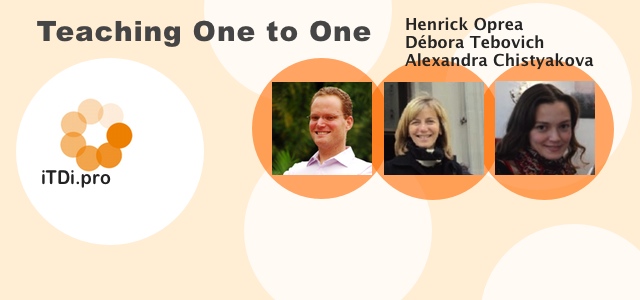
Some Guidelines For Teaching One-To-One
– Alexandra Chistyakova
There is an upsetting disproportion between the amount of available teacher resourses designed for teaching groups and those for teaching one-to-one. While there are a really huge number of materials for working in groups, the resources specifically written for the use in a one-to-one classroom are somewhat scanty. And though some of the group-oriented materials could be adjusted to the individual lessons, they sometimes fail to be efficient enough and to meet the specific one-to-one teaching and learning situation. As Peter Wilberg puts it: “teachers face an almost lack of published materials written with them in mind. It is not very helpful to use course books with instructions such as Get the students to stand in a circle.” [2002, Heinle] The above disproportion concerns not only teacher resources but also the teaching methods and techniques for managing one-to-one classes.
All this makes one-to-one teaching a largely disregarded field of teaching. One may ask a truly legitimate question here: why is it so? The answer is that one-to-one teaching is a highly personalized and utterly unique process. Each student is unique, thus each one-to-one lesson is unique too. What works for one student may not work for another. That’s why it is rather challenging to produce generalized materials. However, it could be only right and, in fact, really useful to put forward some general principles that govern one-to-one teaching.
Below are the guidelines I have derived when reflecting on my one-to-one teaching experience.
- Be flexible. Be ready in the lesson to drop your lesson plan all together. Be prepared for the lesson or classroom discussion to stray in unpredictable directions. Spontaneity and unpredictability are an integral part of one-to-one teaching. Do not resist it: rather let your student do, discuss or ask questions about what they are genuinely interested in at the moment. However, be also aware of subversive behavior of young and teenage learners who sometimes pretend to be interested in questions they are asking you but, in fact, are just trying to avoid doing the lesson. That’s why teachers need to be flexible but at the same time they should not let the lesson get completely out of their control. Try to see a teaching and learning opportunity in everything that is happening in the lesson and try to gently steer your student toward their learning goals.
- Be patient. Be more patient. Never get tired of being patient with your student. Even when you have explained the same point dozens of times but your student still doesn’t fully get it or shows no sign of really making an effort to use it and all this makes you want just to explode – be patient still. Take a deep breath and start all over again. Try to find a new approach for explaining or illustrating the point. For this end, you will need another quality – creativity.
- Be creative. Creativity is helpful not only for a teacher to come up with new ways of explaining the same topic several times. More often creativity in one-to-one teaching is indispensible to address the needs and learning style of a particular learner. We should be creative and resourceful to be able to find the words, images, associations or lesson style and organization that best suit the particular learner.
- In order to meet the unique needs of our individual learners, we should be attentive to what is happening in the classroom. We have no right to switch off for a little while just to give ourselves a tiny break during a lesson as we sometimes do when teaching groups. Teaching one-to-one requires teacher’s full attention: the teacher needs to be always present and involved in the lesson. We should be observant and sensitive to the smallest changes in the course of the lesson and learners’ mood and situation. A teacher is like a fine-tuned instrument responsive to the slightest alterations.
- See a personality in your student. Take them as a whole person with their own problems, joys, aspirations and ambitions. Try to remember everything your students are sharing with you. Exploit your students’ context and environment for teaching purposes but do it appropriately and carefully so that not to hurt them accidentally. All this is highly important as it helps to build rapport with your student. Remember: it takes two to tango. Your student and you are both in it. And if you want your joint journey to be successful and pleasant for both you need to get to know each other better.
- Be enthusiastic about the language. Pass on your passion for the language to your students. Make them see the logic and beauty of the language. Let them enjoy working with and discovering new linguistic features. Make them want to start their own journey into the world of the language. Help them realize that the language is theirs to explore and enjoy. Help your learners to avoid the mechanical, I’ll-learn-a-number-of-words-and-grammar structures-and-be-able-to-speak-it attitude to the language. Bring in some poetic or humorous flair into the language learning. Let your students have fun!
And don’t forget to have fun too!
Also, we should be active and initiative to solve the problems we face. The disproportion in available one-to-one materials I was talking about at the beginning can be balanced up if we all collaborate! So, if you have some one-to-one ideas and techniques you would like to share with other teachers, I’m happy to invite you to the 1-2-1 Facebook group and wiki where we have set the goal to collect useful tips or lesson plans for all teachers who happen to teach one-to-one. We haven’t collected much so far but we are hopeful that the project will bring fruit in the end. Thank you!
Links:
1-2-1 Facebook group: https://www.facebook.com/groups/154531554730094/
1-2-1 Wiki: http://onetoonewiki.pbworks.com/w/page/67383628/1-2-1%20Front%20page
Connect with Alexandra and other iTDi Associates, Mentors, and Faculty by joining iTDi Community. Sign Up For A Free iTDi Account to create your profile and get immediate access to our social forums and trial lessons from our English For Teachers and Teacher Development courses.










